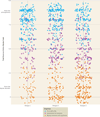Identification of Distinct Psychosis Biotypes Using Brain-Based Biomarkers
- PMID: 26651391
- PMCID: PMC5314432
- DOI: 10.1176/appi.ajp.2015.14091200
Identification of Distinct Psychosis Biotypes Using Brain-Based Biomarkers
Erratum in
-
CORRECTION.Am J Psychiatry. 2016 Feb 1;173(2):198. doi: 10.1176/appi.ajp.2015.1732correction1. Am J Psychiatry. 2016. PMID: 26844802 No abstract available.
Abstract
Objective: Clinical phenomenology remains the primary means for classifying psychoses despite considerable evidence that this method incompletely captures biologically meaningful differentiations. Rather than relying on clinical diagnoses as the gold standard, this project drew on neurobiological heterogeneity among psychosis cases to delineate subgroups independent of their phenomenological manifestations.
Method: A large biomarker panel (neuropsychological, stop signal, saccadic control, and auditory stimulation paradigms) characterizing diverse aspects of brain function was collected on individuals with schizophrenia, schizoaffective disorder, and bipolar disorder with psychosis (N=711), their first-degree relatives (N=883), and demographically comparable healthy subjects (N=278). Biomarker variance across paradigms was exploited to create nine integrated variables that were used to capture neurobiological variance among the psychosis cases. Data on external validating measures (social functioning, structural magnetic resonance imaging, family biomarkers, and clinical information) were collected.
Results: Multivariate taxometric analyses identified three neurobiologically distinct psychosis biotypes that did not respect clinical diagnosis boundaries. The same analysis procedure using clinical DSM diagnoses as the criteria was best described by a single severity continuum (schizophrenia worse than schizoaffective disorder worse than bipolar psychosis); this was not the case for biotypes. The external validating measures supported the distinctiveness of these subgroups compared with clinical diagnosis, highlighting a possible advantage of neurobiological versus clinical categorization schemes for differentiating psychotic disorders.
Conclusions: These data illustrate how multiple pathways may lead to clinically similar psychosis manifestations, and they provide explanations for the marked heterogeneity observed across laboratories on the same biomarker variables when DSM diagnoses are used as the gold standard.
Figures



Comment in
-
Challenges Facing the Identification of Neurobiologically Distinct Psychosis Subtypes: Response to Neuhaus.Am J Psychiatry. 2016 Aug 1;173(8):838-9. doi: 10.1176/appi.ajp.2016.15121596r. Am J Psychiatry. 2016. PMID: 27477140 No abstract available.
-
Importance of Control Biotypes to Distinguish Distinct Psychosis Biotypes.Am J Psychiatry. 2016 Aug 1;173(8):838. doi: 10.1176/appi.ajp.2016.15121596. Am J Psychiatry. 2016. PMID: 27477141 No abstract available.
References
-
- Waltman P, Pearlman A, Mishra B. Interpreter of maladies: re-description mining applied to biomedical data analysis. Pharma-cogenomics. 2006;7:503–509. - PubMed
Publication types
MeSH terms
Grants and funding
LinkOut - more resources
Full Text Sources
Other Literature Sources
Medical

